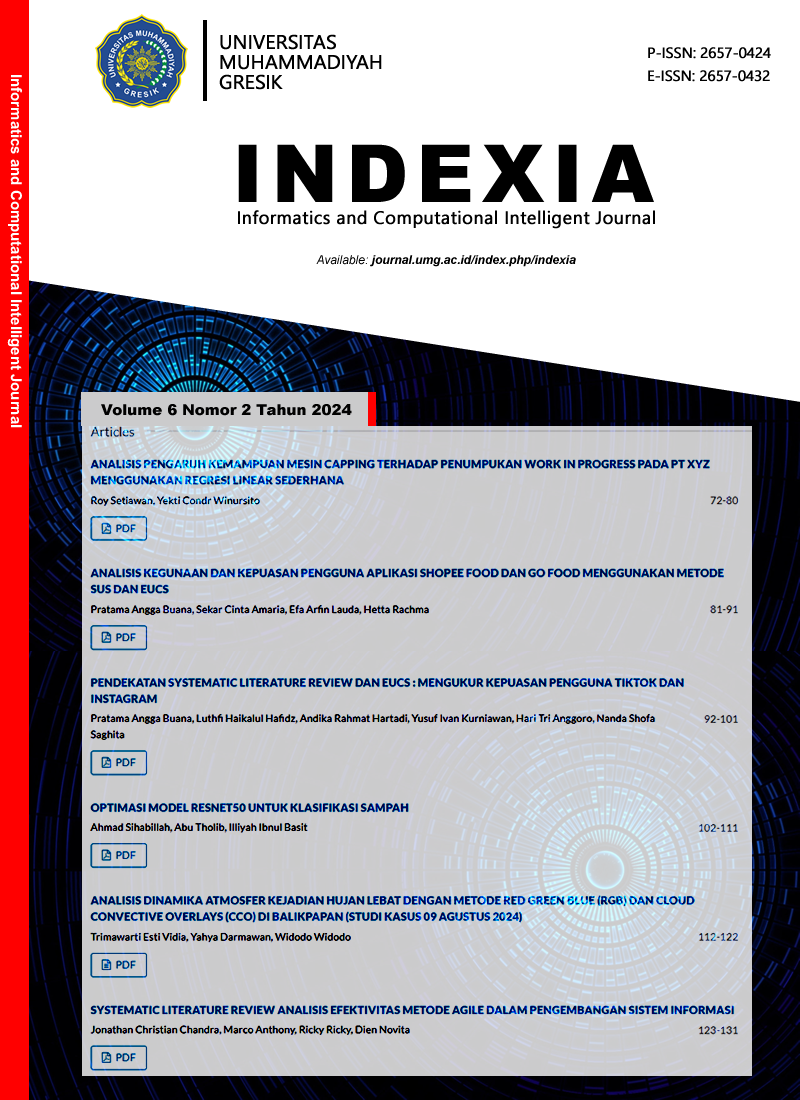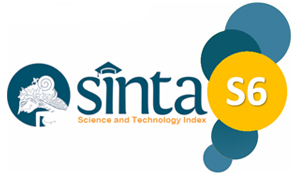OPTIMASI MODEL RESNET50 UNTUK KLASIFIKASI SAMPAH
DOI:
https://doi.org/10.30587/indexia.v6i2.9342Keywords:
ResNet50, klasifikasi sampah, organik, anorganikAbstract
Penelitian ini mengkaji pemanfaatan arsitektur ResNet50 dalam klasifikasi sampah organik dan anorganik untuk meningkatkan efisiensi pemilahan sampah secara otomatis. Dataset yang digunakan terdiri dari 12.565 gambar sampah organik dan 9.999 gambar sampah anorganik, mencakup berbagai variasi kondisi lingkungan, seperti pencahayaan, ukuran, dan bentuk. Tahapan penelitian meliputi preprocessing data, yang mencakup augmentasi gambar untuk menambah variasi, pembagian dataset menjadi data pelatihan dan validasi, serta penyesuaian bobot kelas untuk menangani ketidakseimbangan dataset. Model dilatih selama lima epoch dengan akurasi validasi tertinggi sebesar 80,15% pada epoch terakhir. Hasil evaluasi menggunakan metrik precision, recall, dan f1-score menunjukkan performa yang baik, dengan kategori sampah organik mencapai recall 91% dan f1-score 84%. Namun, kategori sampah anorganik memiliki precision sebesar 85% dengan recall yang lebih rendah, yaitu 67%. Analisis Confusion matrixmengungkapkan bahwa model mampu mengklasifikasikan sebagian besar sampel dengan benar, meskipun masih terdapat beberapa kesalahan pada kategori anorganik. Secara keseluruhan, penelitian ini membuktikan efektivitas ResNet50 dalam meningkatkan akurasi klasifikasi sampah, mendukung pengelolaan sampah yang berkelanjutan. Dengan optimisasi lebih lanjut, seperti penyesuaian hyperparameter atau augmentasi tambahan, model ini memiliki potensi untuk mencapai performa yang lebih tinggi dalam aplikasi praktis.
References
[2] Z. Wang, W. Zhou, and Y. Li, “Garbage FusionNet: A deep learning framework combining ResNet and Vision Transformer for waste classification,” 2024.
[3] T. K. Tran, K. T. Huynh, D.-N. Le, M. Arif, and H. M. Dinh, “A Deep Trash Classification Model on Raspberry Pi 4.,” Intelligent Automation & Soft Computing, vol. 35, no. 2, 2023.
[4] Z. Feng, J. Yang, L. Chen, Z. Chen, and L. Li, “An intelligent waste-sorting and recycling device based on improved EfficientNet,” Int J Environ Res Public Health, vol. 19, no. 23, p. 15987, 2022.
[5] M. M. Hossen et al., “A Reliable and Robust Deep Learning Model for Effective Recyclable Waste Classification,” IEEE Access, vol. 12, pp. 13809–13821, 2024, doi: 10.1109/ACCESS.2024.3354774.
[6] Z. Qiao, “Advancing Recycling Efficiency: A Comparative Analysis of Deep Learning Models in Waste Classification,” arXiv preprint arXiv:2411.02779, 2024.
[7] O. Adedeji and Z. Wang, “Intelligent waste classification system using deep learning convolutional neural network,” Procedia Manuf, vol. 35, pp. 607–612, 2019.
[8] M. Liu, L. Chen, X. Du, L. Jin, and M. Shang, “Activated gradients for deep neural networks,” IEEE Trans Neural Netw Learn Syst, vol. 34, no. 4, pp. 2156–2168, 2021.
[9] K. M. Jon Tarnate, M. Devaraj, and J. C. De Goma, “Overcoming The Vanishing Gradient Problem Of Recurrent Neural Networks In The Iso 9001 Quality Management Audit Reports Classification,” INTERNATIONAL JOURNAL OF SCIENTIFIC & TECHNOLOGY RESEARCH, vol. 9, no. 03, 2020, [Online]. Available: www.ijstr.org
[10] F. Wu and H. Lin, “Effect of transfer learning on the performance of VGGNet-16 and ResNet-50 for the classification of organic and residual waste,” Front Environ Sci, vol. 10, p. 1043843, 2022.
[11] M.-H. Huynh, P.-T. Pham-Hoai, A.-K. Tran, and T.-D. Nguyen, “Automated waste sorting using convolutional neural network,” in 2020 7th NAFOSTED Conference on Information and Computer Science (NICS), IEEE, 2020, pp. 102–107.
[12] F. Wu and H. Lin, “Effect of transfer learning on the performance of VGGNet-16 and ResNet-50 for the classification of organic and residual waste,” Front Environ Sci, vol. 10, p. 1043843, 2022.
[13] O. Rainio, J. Teuho, and R. Klén, “Evaluation metrics and statistical tests for machine learning,” Sci Rep, vol. 14, no. 1, p. 6086, 2024.
[14] E. E. O. Avilés, D. Olmos-Liceaga, and J.-H. Jung, “Stratified Sampling Algorithms for Machine Learning Methods in Solving Two-scale Partial Differential Equations,” arXiv preprint arXiv:2405.15686, 2024.
[15] Z. Wang, Q. Xu, Z. Yang, Y. He, X. Cao, and Q. Huang, “A unified generalization analysis of re-weighting and logit-adjustment for imbalanced learning,” Adv Neural Inf Process Syst, vol. 36, 2024.



 Template INDEXIA
Template INDEXIA



